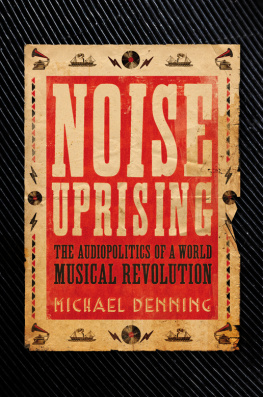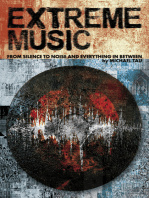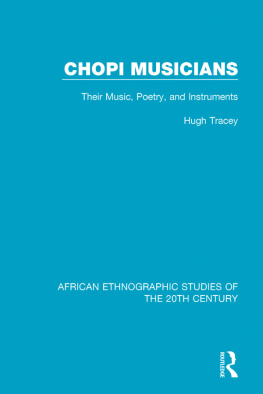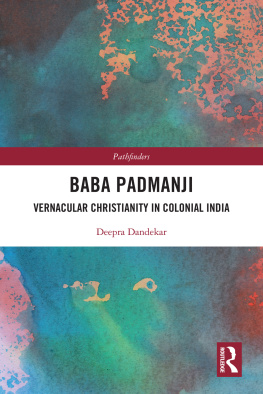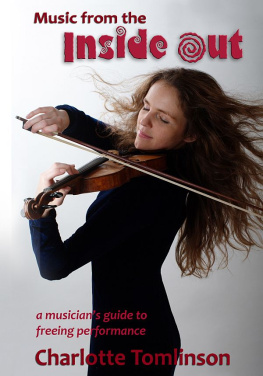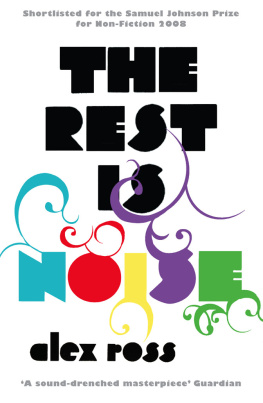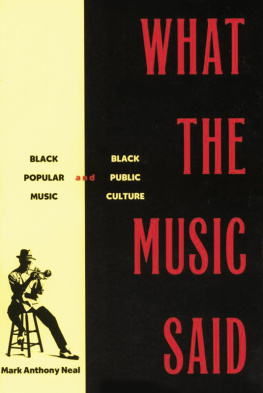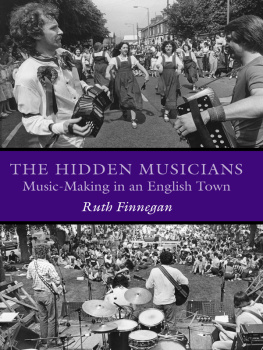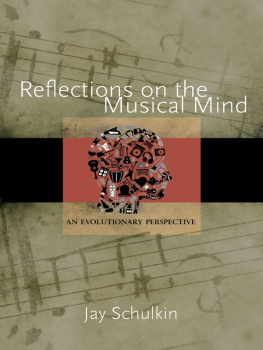MICHAEL DENNING is the William R. Kenan, Jr., Professor of American Studies at Yale University, and the co-director of Yales Initiative on Labor and Culture. He is the author of Culture in the Age of Three Worlds; The Cultural Front: The Laboring of American Culture in the Twentieth Century; Mechanic Accents: Dime Novels and Working-Class Culture in America; and Cover Stories: Narrative and Ideology in the British Spy Thriller. He coordinates the Working Group on Globalization and Culture, whose collective work includes Going into Debt, published online in Social Texts Periscope, and Spaces and Times of Occupation, published in Transforming Anthropology. In 2014, he received the Bode-Pearson lifetime achievement award from the American Studies Association.
Noise Uprising

The Audiopolitics of a
World Musical Revolution
Michael Denning

First published by Verso 2015
Michael Denning
All rights reserved
The moral rights of the author have been asserted
1 3 5 7 9 10 8 6 4 2
Verso
UK: 6 Meard Street, London W1F 0EG
US: 20 Jay Street, Suite 1010, Brooklyn, NY 11201
www.versobooks.com
Verso is the imprint of New Left Books
ISBN-13: 978-1-78168-856-4 (PB)
ISBN-13: 978-1-78168-855-7 (HC)
eISBN-13: 978-1-78168-858-8 (US)
eISBN-13: 978-1-78168-857-1 (UK)
British Library Cataloguing in Publication Data
A catalogue record for this book is available from the British Library
Library of Congress Cataloging-in-Publication Data
Denning, Michael.
Noise uprising : the audiopolitics of a world musical revolution / Michael Denning.
pages cm
Includes index.
ISBN 978-1-78168-856-4 (alk. paper)ISBN 978-1-78168-855-7 (alk. paper)ISBN 978-1-78168-858-8 (alk. paper)ISBN 978-1-78168-857-1 (alk. paper) 1. PhonographSocial aspectsHistory20th century. 2. Sound recordingsSocial aspectsHistory20th century. 3. Popular music19211930History and criticism. I. Title.
ML3916.D48 2015
781.6309042dc23
2015005266
Typeset in Adobe Caslon Pro by MJ & N Gavan, Truro, Cornwall
Printed in the US by Maple Press
words,
for Fred Jameson
music,
for Tony Lombardozzi
Insurgency was a massive and systematic violation of those words, gestures, and symbols which had the relations of power in colonial society as their significata. This was perceived as such both by its protagonists and their foes. The latter were often quick to register their premonition of an uprising as a noise in the transmission of some of the more familiar signals of deference.
Ranajit Guha, Elementary Aspects of Peasant Insurgency in Colonial India
We would also uncover the same transformations, the same progress and the same eagerness if we enquired into the fields of dance, song, rituals, and traditional ceremonies. Well before the political or armed struggle, a careful observer could sense and feel in these arts the pulse of a fresh stimulus and the coming combat.
Frantz Fanon, The Wretched of the Earth
Contents
List of Figures and Illustrations
In the early twenty-first century, the world of music is in constant crisis and flux, but its overall lineaments are relatively clear and appear natural. The internet has emerged as a global jukebox of digital sound files that are uploaded, downloaded, streamed and shared, accumulated as collections, shuffled into playlists, and sampled as raw materials for new mixes. The vehicles of circulation may changeiTunes, Spotify, and YouTube loom large as I complete this bookbut it seems self-evident that the wealth of music in a world where capitalist modes of production prevail appears as an immense accumulation of commodities. These sound recordings exist in an intricate economy of genres, styles, and brands, linked to imagined communities of race and nation, and are adopted by consumers to manage their personal and collective soundscapethe ambience or atmosphere of daily lifewhether through the privacy of earbuds and headphones or the publicity of DJs with sound systems.
At the same time, writing about music takes place on two radically different scales: grand generalizations about the meaning of music in the evolution of the species (its relation to language, to the order and disorders of the brain, to the sounds and songs of other species); and rough guides to the musical marketplace, micro-histories of specific genres and artists. The traditional sense that music is a fine art lives on in the residual culture of classical music, which has lost much of its former glory and occupies a small market niche, while retaining some degree of cultural capital. And the older sense that music-making is a political actwhich led Plato to assert that any alteration in the has also receded to the fringes of the musical marketplace, where the germ of an alternative culture lies in songs of protest affiliated with social movements. It is not that the contemporary world of music lacks an audiopolitics, but rather that it is coded as the politics of the market: who owns and controls the sound files. The politics of intellectual property and piracy have eclipsed the politics of musical form or content.
This musical economy that incorporates arcane sounds and sublime frequencies from every corner of the planet seems new, the product of an era of globalizationthe sound equivalent of the World Wide Web itselfbut when it is given a history and a context, it usually appears to radiate out from the United States, from the postWorld War II explosion of American musics from rock to rap. Elvis Presley, the Beatles, and Bob Dylan are the Mozart, Haydn, and Beethoven of a second classical period, and the furious late twentieth-century battles over the hip-hop of Public Enemy and N.W.A. echo the late nineteenth-century furor over the operatic spectacles of Richard Wagner.
In this book, I want to offer an alternative account of the origins of our musical world: not in the rock and pop of the American century, but in a world musical revolution that took place almost a century ago. In a few short years between the introduction of electrical recording in 1925 and the onset of the worldwide depression in the 1930s, a noise uprising occurred in a series of relatively unnoticed recording sessions. In port cities from Havana to Honolulu, Cairo to Jakarta, New Orleans to Rio de Janeiro, commercial recording companies brought hundreds of unknown musicians into makeshift studios to record local musics. Thousands of inexpensive discs made from shellac (a resin secreted by the female lac bug, a colonial product harvested in the forests of South Asia) were released, disseminating musical idioms which have since reverberated around the globe under a riot of new names: son, rumba, samba, tango, jazz, calypso, beguine, fado, flamenco, tzigane, rebetika, arab, marabi, kroncong, hula.
These recording sessions of vernacular musicians in the late 1920s stand out in the history of music like a range of volcanic peaks, the dormant but not extinct remains of a series of eruptions caused by the shifting of the tectonic plates of the worlds musical continents. For five years, more or less, these eruptions took place as gramophone and phonograph companies fought with each other to capture the worlds bubble of the 1990s. The recording boom took off around 1925, as the new technology of electrical recording enabled not only an extraordinary leap in audio fidelity but also a dramatic reduction in the cost of phonographs. It is hard to overestimate the sonic transformation; to this day, we listen with pleasure to reissues of the earliest electrical recordings, whereas the slightly older acoustic recordings are a dead language, a kind of sonic Middle English, the preserve of archivists whose ear training allows them to revisit the archaic soundscape of the Edison cylinders and the hill-and-dale discs.

